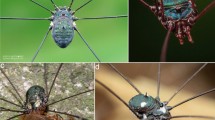Abstract
So far as is known, the majority of Reduviidæ are predators of other insects, and consequently their anterior legs in particular, with the median legs, are of utmost importance in assisting them to capture their prey, especially when it is an active insect. But, in spite of their predaceous habits, it is perhaps remarkable that few Reduviidæ, with the exception of the sub-family Emesinæ and the Old World genera, Irantha, Polydidus and Scipinia, possess anterior legs of the raptorial type.
Similar content being viewed by others
References
"The Climbing Organ of an Insect Rhodnius prolixus (Hemiptera, Reduviidæ)", Proc. Roy. Soc., B, 111 (1932).
Author information
Authors and Affiliations
Rights and permissions
About this article
Cite this article
MILLER, N. Function of the 'Fossula spongiosa' or Spongy Furrow in Reduviidæ (Rhynchota). Nature 141, 749–750 (1938). https://doi.org/10.1038/141749b0
Published:
Issue Date:
DOI: https://doi.org/10.1038/141749b0
- Springer Nature Limited
This article is cited by
-
The Fossula Spongiosa in Reduviidæ
Nature (1939)
-
‘Climbing Organs’ in Insects
Nature (1938)





